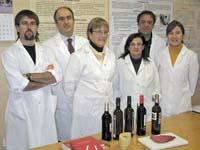Sensory analysis

Sensory analysis measures and evaluates the sensations produced by a product. This analysis applies to sectors such as textiles, automotive and food. Develop methods of evaluation of sensory characteristics in each case. In this way, it is possible to ensure that the products are adjusted to the defining characteristics. The application of this type of analysis allows manufacturers to guarantee a minimum quality of products.
The LASEHU works in the sensory analysis of food, especially in the quality control of food with distinctive quality, such as those of origin. Methods of analysis of the Idiazabal cheese and the young red wine of Rioja Alavesa have been developed, and methods of analysis of the red wine of Rioja Alavesa aged in barrels, the Txakoli of Bizkaia, the Txakoli of Álava and the Basque Meat are being developed.
To develop the method of sensory analysis of a food are met experts - producers, gastronomic, technicians, etc.-. With them are established the necessary parameters to measure the quality of the product, such as characteristics, references and scales.
Once the method is developed, a group of tasters train to evaluate a particular product. They must pass selection tests and a basic food assessment training -- to ensure the required sensory sensitivity. During the months of training, tasters learn to evaluate based on scales, references, etc. Agreed in the method, and little by little they score all the characteristics of the product. After training, each taster must demonstrate with tests the ability to be in the team of experts.
Method of tasting
The method that is developed establishes all the details of the tasting process: order of evaluation of the parameters, methodology of evaluation of the same, criteria of score, etc.
In the first place, a cata of criteria is performed to ensure that the entire group evaluates equally and then the tasting is done. In those cases where the appearance of the product can influence the olfactory and taste analysis, the taste and olfactory analysis is done in the dark or with red and green light. Then, with a light similar to natural light, the appearance is evaluated. In addition, all factors that can influence the tasting are controlled: temperature of the product tasting time, temperature and humidity of the gel, etc.

With the data obtained, the researcher compiles a report of the positive and negative characteristics identified by the tasters in each product. With them is completed the technical sheet of the product that allows to analyze the evolution of the sensory characteristics of the same.
Sensory memory sensory memory
The tasters must have sensory memory, that is, know to always identify the same characteristics in the same way. Therefore, leaving a time between tastings, the note that is given to the same product must be similar. In this sense, tasters must be able to score the same product several times equally on the same day, although they differentiate the different products of the same type.
To ensure the reliability of the results, tasters must train and prepare each year. In this way, the technical capacity of the team is demonstrated. In the sensory analysis of a food, the group of tasters becomes a "machine" of analysis, and a group of well-calibrated tasters can be as accurate as an automatic instrument.






